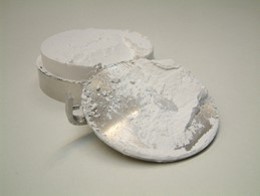After storage of powder, the intention is usually to make the powder flow or yield again. With free flowing materials the shearing of the material is easily performed. With more cohesive materials, the initiation of flow is more difficult. These flow characteristics under consolidated conditions can be studied by shear testing. Shear testing methodologies can be executed following different principles and methodologies.
Jenike’s method is the most common method to measure flow properties after steady state flowing. The method applies the history to the powder by consolidation under pressure after which the resulting failure strength is measured to initaite flow which of course is related to powder flow. In this way the situation in a silo or hopper is simulated, in which the powder undergoes a certain history of shear and consolidation in the top giving it strength when it reaches the bottom of the silo or hopper. The Jenike shear cell can analyze internal friction and wall friction on various wall surfaces. All this information can be used to make an adequate silo design that is suitable for the product investigated.
A more modern version of Jenike’s approach to measure powder flow is the ring shear cell tester, which enables a much larger displacement than the conventional Jenike cell is is nowadays more often used for shear testing investigations.
Typically, for powder flow investigations by shear testing, a sample is placed in a ring shear cell of specific dimensions. The specimen is pre-consolidated by twisting or turning the shear cell cover while applying a compressive load normal to the cover. Subsequently, using a normal load to the shear cell cover, the specimen is pre-sheared until a steady state. Finally, shearing in horizontal direction under a reduced load results in a shear force that goes through a maximum value. This maximum value is representative and also unique for a powder under certain conditions. The rotational split level shear tester designed by Peschl rotates the powder over itself producing a torque from which the shear stress can be calculated.
The data points (maximum shear vs load) obtained by shear testing result in a yield locus with two Mohr circles. Several sets of Mohr circles provide a flow function. Combination of internal friction measurements with wall friction and bulk density measurements enables silo/hopper design resulting in a rational estimation of the hopper half angle and outlet opening of the hopper section enabling mass flow. Since the wall friction that the product is experiencing greatly depends on the type of wall material, we have wall friction lids of different material available: SS304, SS316, aluminium, steel, glass fiber-reinforced plastic, and others. Combining all this information enables a best silo design for reliable powder flow.
In our laboratory we can also perform time-consolidated powder flow experiments that mimic storage of the powder product over a longer period of time and therefore such study provides more realistic powder flow data for storage in a silo or hopper. In our shear testing studies over a wide variety of materials, we have frequently seen that the powder flow properties can dramatically change with time consolidation. Additionally, the ring shear testing experiments can be executed under controlled conditions of temperature and relative humidity in order to also include environmental conditions in the powder flow study. To this end, the ring shear testing equipment is positioned in a climate chamber with given temperature and relative humidity. The impact of relative humidity and time can be of even greater impact on the powder flow characteristics . Only in this way, an optimal and realistic silo design can be pursued. This approach is best for designing powder flow associated with storage in a hopper or silo.
Recent developments have also enabled the usage of a powder rheometer in which a small shear testing device can be included. The main advantage of this concept is that with the powder rheometer very small sample volumes can be appllied for shear testing. This can be of interest for products that are either very expensive or in case only a small volume is available.
If analysis of the powder flow under non-consolidated conditions is of interest, then flow through orifice, use of a powder rheometer, or flowability and floodability investigations by the Hosokawa powder tester can be applied. Dramatic changes in powder flow leading to a powder caking phenomenon can be studied by means of the uni-axial compact strength testing methodology.

- Powder Flow and Ring Shear Testing
- Unconfined powder flow testing
- Powder Caking by Uni-axial compact strength testing
- Powder stickiness measurement
- Heubach and EN 15051 dustiness analysis
- Attrition and abrasion of particles, granules and tablets
- Segregation testing of powders and solids
- EN 17199-4 Dustiness index and nano particles
- Oil Absorption Number analysis of carbon black
- Powder conductivity testing
- Tribo Electrostatic charging of powders



